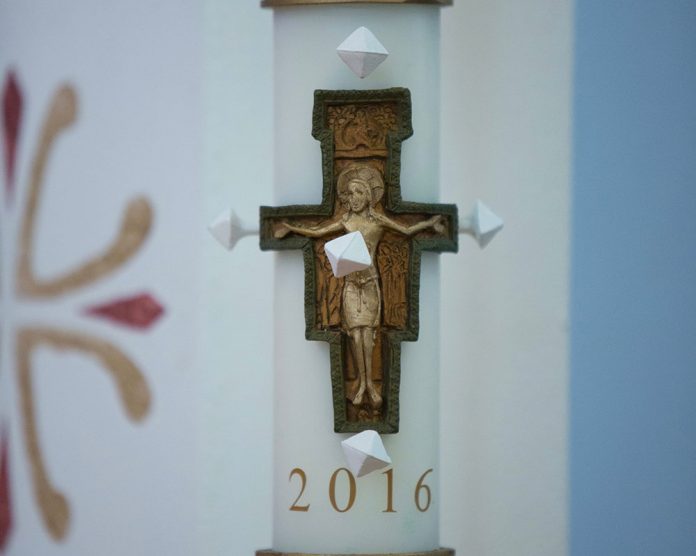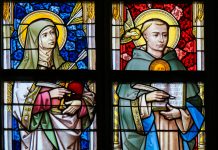
by Janet Schaeffler, Kate Ristow, Dan Thomas, Chris Weber
Can my students and I bless the Advent wreath on our prayer table?
Q: I’m a first-year catechist. I’m going to have my students make an Advent wreath for our prayer table the week before Advent begins. I want all of us to bless the wreath. But is it “orthodox” for me and the kids to do a blessing like that? If not, why not? If it’s ok, are there certain words or a specific formula we should follow?
—E. P., fifth-grade catechist
Kate Ristow’s Answer
A: Yes! You and your students have every right to bless the wreath. The United States Catholic Catechism for Adults states that “By their Baptism (lay people) share in Christ’s priesthood and are sealed by the Spirit. They are thus called to holiness, to a prophetic witness in the world, and to a kingly resolve to sanctify the world by their words and deeds” (Chapter 11, Doctrinal Statements).
Your fifth-graders are old enough to understand this and to make the distinction between blessings they may give and those blessings more proper for a deacon, priest, or bishop.
For example, you might tell them that their right to bless does not extend to giving the final blessing at Mass or using Chrism to anoint and bless a child at Baptism. These are responsibilities given to the ordained clergy. However, they are called to be a “blessing and to bless” (see Catechism of the Catholic Church, n. 1669). The article titled “Ritual Prayer: Exploring, Experiencing, and Celebrating” offers more ideas about blessings your students can give. (Go to catechist.com, Article Archive, Search the Archive and enter KEYWORDS ritual prayer and AUTHOR Ristow.)
There are many options for blessing an Advent wreath. Both the Book of Blessings and your December parish missalette offer blessings you can use or adapt. Or you can use the format below:
Invite students to gather around the Advent wreath. You will need a small bowl of holy water and sprinkling sprig; you will also need three volunteers. Begin by making the Sign of the Cross together.
Catechist: Loving Father, thank you for sending your only Son, Jesus, to save us. During this Advent Season, help us to prepare to welcome Jesus into our hearts. We ask this in the name of our Messiah, Jesus Christ.
All: Amen.
Invite a student to sprinkle holy water on the wreath as you pray:
Catechist: Bless this wreath, O Lord. May it be a sign of your promises to us, your children.
Have three volunteers read aloud the following prayers. Ask students to respond “Come, Lord Jesus!” Invite students to extend their hands over the wreath during the prayers and responses.
First Volunteer: May the green branches of the wreath remind us of the new life Christ won for us. We pray…All: R.
Second Volunteer: May the circle that forms the wreath remind us of God’s never-ending love. We pray… All: R.
Third Volunteer: May the candles light the way to following your example of love, service, and caring for our neighbors. We pray… All: R.
Catechist: Lord Jesus, help us to prepare for the celebration of Christmas. Fill us with your life and light.
All: Amen.
Kate Ristow, Contributing Editor to CATECHIST, has worked in Catholic publishing for over 25 years as a national speaker and writer, building on a wealth of experience in the religious formation of children and catechists in both parish and Catholic school programs.
Janet Schaeffler’s Answer
A: What a wonderful idea! The Advent wreath is one of our traditions that touches people and links them through prayer and our senses to the meaning of the season. By changing what’s on your prayer table, you are helping students realize and recognize the celebrations of our liturgical year. (Begin to think now about what you will place on the table during other liturgical seasons.)
The U.S. bishops’ website says that the “use of the Advent wreath is a traditional practice which has found its place in the Church as well as in the home. The blessing of an Advent wreath takes place on the First Sunday of Advent or on the evening before the First Sunday of Advent. When the blessing of the Advent wreath is celebrated in the home, it is appropriate that it be blessed by a parent or another member of the family” (bit.ly/18CMybU). Within your catechetical setting, you are a community, a family, a household.
The Shorter Book of Blessings states that the Advent wreath “may be blessed by a priest, deacon, or a lay minister” (n. 933; see ewtn.com/library/LITURGY/adbless.htm). As a catechist, you are an important lay minister, a leader within your faith formation community of learners.
Both resources provide suggested prayers for the blessing of the Advent wreath.
The U.S. bishops’ website also suggests “Blessings of a Christmas Manger or Nativity Scene,” “Blessing of a Christmas Tree,” and “Blessing of the Home and Household on Epiphany” (see usccb.org/prayer-and-worship/blessings/objects). These blessings are contained in Catholic Household Blessings and Prayers (United States Conference of Catholic Bishops, revised edition, 2007). Why not send these blessings home with your students, suggesting and encouraging families to celebrate blessings within their families?
After many years in parish and diocesan catechetical ministry, Janet Schaeffler, OP, is currently involved in catechetical/adult faith formation consultation, writing, workshops, days of reflection/retreats, and teaching. Her website is janetschaeffler.com.
How can I explain to young children the story of the Holy Family’s flight into Egypt?
Q: During one of my classes after Christmas last year, we read the story of the Holy Family’s flight into Egypt (Matthew 2:13-18). This upset one of my third-graders who had a newborn brother. Crying uncontrollably, she asked, “Why did God save his Son but let all those other little babies get killed?” My response to her was so inadequate. All I could think of to say was that God’s ways are very hard to understand sometimes, and that we are happy that those children are saints with God in heaven for all eternity. How can I avoid this happening again? How can I explain this inexplicable act to my students? Or should I just skip telling them the story?
—Alice T.
Chris Weber’s Answer
A: What an unfortunate incident! I am sure that many catechists have been caught off guard by a student reaction like this. Sometimes kids who are going through a big event—like a new child in the house, starting at a new school, or a family tragedy—will react in an unusually strong manner to class content. In such cases, there is nothing you can do but respond to the child with compassion. At other times, it is probably best to avoid content that children might find frightening or offensive. In my opinion, the scenario you describe is one of those times.
The number-one resource to help you avoid situations like this in the future is your catechetical textbook. Textbooks used by most parishes contain lessons and activities that are developmentally appropriate for your students. If your textbook does not contain enough resources connected to the liturgical year, ask your catechetical leader to help you find a Scripture-based resource for third-graders. These resources will sometimes suggest an abbreviated version of the reading or will provide hints on how to highlight other aspects of the reading that third-graders will find less disturbing.
You have rightly labeled the acts in the reading as “inexplicable.” Children should not be exposed to such acts of terror—although increasingly, through media reports and even through incidents in their cities and homes, they experience them. In the face of such evil, I think it is important to tell children that these things happen because of the wrong choices that human beings make. God does not want anything but good for us!
Chris Weber has worked in the field of catechesis for over 20 years as a catechist, a parish catechetical leader, and a diocesan staff member. He is the author of Jesus-Style Recruiting: A Fresh Look at Recruiting and Forming Parish Volunteers, published by Visual Dynamics Publishing. He currently serves as Registrar at Mount St. Mary’s University in Emmitsburg, MD.
Dan Thomas’s Answer
A: Your third-grader’s question is one that is difficult to respond to because it came up spontaneously, was a very challenging question, and required a sensitive response due to the emotion involved. Recently, in an RCIA group, this happened to me because there was lack of sufficient time to make an adequate response to a young woman’s question. I did my best but wasn’t happy with the result. I hope someone in the future will be able to do better than I did.
This same type of question is raised by a number of Scripture passages used in our teaching. In addition, the way we often describe how God is involved in our world and our lives causes similar difficulties. Scripture uses several different literary forms to teach about God and humankind’s relationship to/with God.
For example, we often use analogy when we talk about God’s involvement in our lives and in history. There is always mystery surrounding how human free will and God’s will interact with each other in life and in Scripture.
The essential truth to keep in mind is that the God we know and love and preach is a loving God, a God who, like all lovers, seeks what is best for those loved. This God of ours has given us the gift of free will, respects that gift, and knows that humans will sometimes misuse the gift. Thus, Herod’s choice had horrific consequences for those affected by the way he chose to misuse the gift of free will.
When we teach Scripture, we need to be conscious of its literary form, knowing that it is not always “history” in our modern sense of the word. This particular story is part of the Infancy Narratives, which present theological truths that are not always historical facts. In fact, many scholars believe that this particular story about Herod is not historically accurate because it is found nowhere else in Scripture or the general history of that era.
In light of the above, how does one respond to the third-grader’s question?
First, begin with a statement: The God we know is a God who loves us always and completely.
Second, present the story as a story that forms only a very small part of our understanding of God, and then mention other Scripture references that tell of God’s bountiful, gentle love (John 3:16-17, God loves us so much he sent his Son; John 15:9-17, Jesus calls us his friends; 1 John 4:19, God loved us first).
I am impressed with your concern for this child and your willingness to ask this question. Our parish programs must provide a context in which those involved experience God’s loving presence and our willingness to help them deal with difficult questions respectfully and responsibly. You show both of these qualities in your questioning and in your search for an adequate response.
Dan Thomas served in catechetical leadership for over 30 years and remains involved in the National Conference for Catechetical Leadership (NCCL). He and his wife, Eileen, are the parents of two adult sons.
Copyright 2013, Bayard, Inc. All rights reserved. This article is protected by United States copyright and other intellectual property laws and may not be reproduced, rewritten, distributed, redisseminated, transmitted, displayed, published or broadcast, directly or indirectly, in any medium without the prior written permission of Bayard, Inc.




